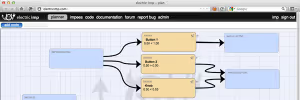
LX Group examines the Electric Imp system
Continuing from our article last week which examined the Twine wireless sensor blocks, we now move forward and explore another recent addition to the Internet-of-Things marketplace in more detail – the “Electric Imp”. Although the name sounds somewhat toy-like, the system itself is quite the opposite. It's a unified hardware, software and connectivity solution that's easy to implement and quite powerful. It offers your devices WiFi connectivity and an incredibly simple development and end-user experience.That's a big call, however the system comprises of a relatively simple hardware solution and software development environment that has a low financial and learning entry level yet is quite customisable. Like other systems it comprises of a hardware and software component, so let's examine those in more detail.Hardware – Unlike other IoT systems such as Twine or cosm, the Electric Imp has a very well-defined and customisable hardware structure that is both affordable and incredibly compact. Almost all of the hardware is in a package the size of an SD memory card, and the only external parts required are a matching SD socket to physically contain and connect with the Imp card with your project, and supporting circuitry for an Atmel ATSHA204 authentication chip which enables Imp cards to identify themselves as unique unitsin the system.

Connection to the cloud service is via a secure 802.11b/g/n WiFi network and supports WEP, WPA and WPA2 encryption, however due to the size of the Imp there isn't an option for a wired connection. The external support schematic is made available by the Imp team so you can easily implement it into almost any prototype or existing product. But how?Imagine a tiny development board with GPIO pins, an SPI and I2C-bus, a serial UART, and a 16-bit ADC inside your project that is controlled via WiFi – this is what the Imp offers. It's quite exciting to imagine the possibilities that can be introduced to existing projects with this level of control and connectivity. From remote control to data gathering, system monitoring to advanced remote messaging systems – it's all possible. Furthermore, due to the possibility of completely internal embedding of the Imp system inside your product, system reliability can be improved greatly as there's no points of weakness such as network cables, removable parts or secondary enclosures.Software – As each Imp is uniquely identifiable on the Imp cloud service, you can use more than one in any application. Furthermore, your Imp firmware is created and transmitted to each Imp card online – which allows remote firmware updates as long as the Imp has a network connection; and a cloud-based IDE to allow collaboration and removes the need for customised programming devices, JTAGs, or local IDE installations. This saves time, money, development costs and offers a more portable support solution.

The firmware is written in a C-like language named “Squirrel”, which is created using the aforementioned online IDE. Once uploaded to the Imp card the firmware can still operate if it loses a network connection – or if a run-time error occurs and a network is available, the details will be sent back to the IDE. This allows developers the ability to remotely debug Imp applications in real-time – saving on-site visits and unwanted client-supplier interactions.Furthermore, Imps have an inbuilt LED which can be utilised to display status modes if an application fails or other information which can be used to a clients' benefit, helping them describe possible issues if a network connection isn't available. There is a detailed language description, a wide range of tutorials and example code to help developers get started - and although some features are still in the beta-stage, the core advertised features are available at the time of writing.If you're interested in moving forward with the Electric Imp, we can guide you through the entire process, from understanding your needs to creating the required hardware interfaces and supplying firmware and support for your particular needs. The up-front hardware cost is much lower than other systems, and with volume pricing the implementation costs can be reduced further.Our goal is to find and implement the best system for our customers, and this is where the LX Group can partner with you for your success. We can create or tailor just about anything from a wireless temperature sensor to a complete Internet-enabled system for you – within your required time-frame and your budget. For more information or a confidential discussion about your ideas and how we can help bring them to life – click here to contact us, or telephone 1800 810 124.LX is an award-winning electronics design company based in Sydney, Australia. LX services include full turnkey design, electronics, hardware, software and firmware design. LX specialises in embedded systems and wireless technologies design. https://lx-group.com.au
Published by LX Pty Ltd for itself and the LX Group of companies, including LX Design House, LX Solutions and LX Consulting, LX Innovations.
.avif)